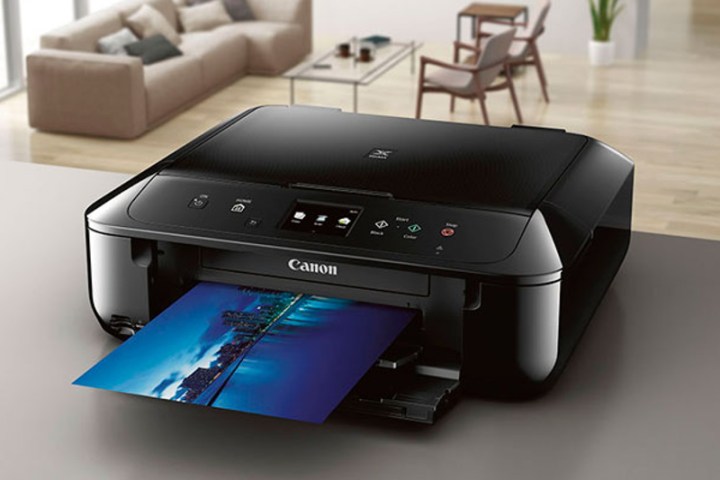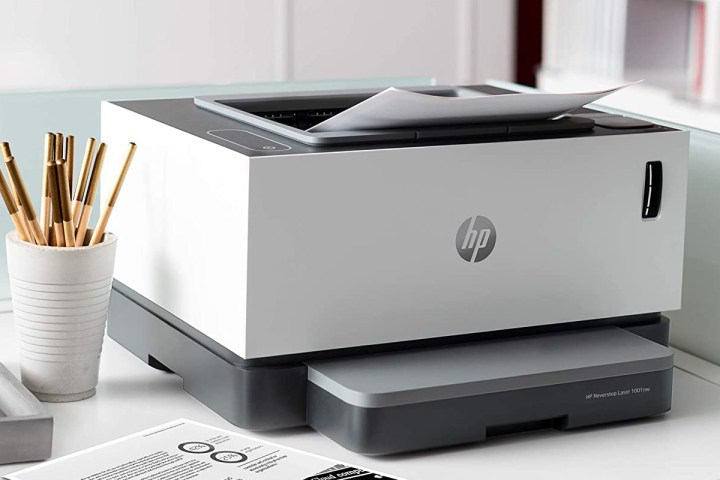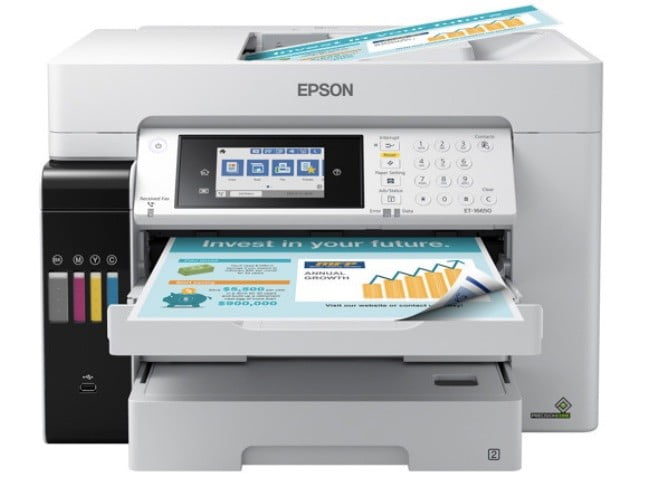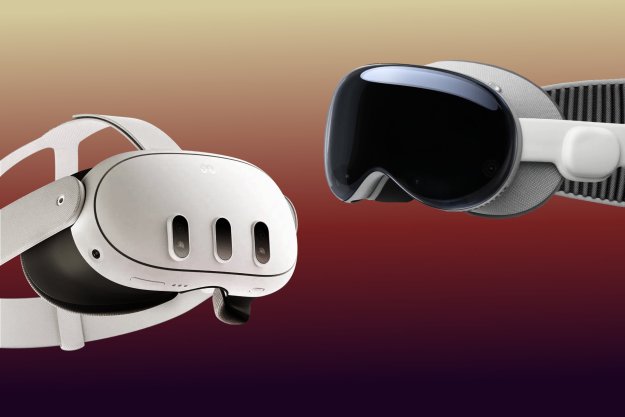Shopping for a new printer can be surprisingly confusing. Along with navigating all the different brands, you’ll also need to figure out if an inkjet or laser printer is best for your needs. Both of these printer types are perfectly acceptable options — but they come with their own sets of advantages and drawbacks.
For example, folks who need a printer to handle text documents might be better suited for one type of printer, while someone who needs to print out high-quality images might need another. Before heading out to look for a new printer, make sure you take note of why you need a printer, as that’ll play a big role in which is best for your needs.
Thankfully, inkjet and laser printers have come a long way over the past few years, and there’s a good chance that both will serve you well regardless of your needs. But if you want to get the most bang for your buck, here’s a look at inkjet vs. laser printers to help you decide which to bring into your home. If you need even more tips, be sure to consult our printer buying guide.
Which type of printer is faster?

Traditionally, laser printers are considered the speed champs, but thanks to advances in printing technology, inkjets have steadily caught up with their rivals. Cheaper inkjet printers, and particularly portable printers designed for travel, are often slower than mainstream laser printers. These printers generally output about eight to 10 pages per minute, but larger, more premium inkjets designed for business use are much more agile.
HP’s latest PageWide Pro 477dw is one example of a speedy inkjet printer that outperforms its laser rivals in printing speeds and costs, but it requires a heftier upfront investment than traditional home inkjet printers. The printer can print at speeds of up to 55 pages per minute, and it is able to do this with HP’s PageWide printing technology. On traditional inkjet printers, the nozzle has to move back and forth on a moveable print head to cover the entire paper width, but with the PageWide technology, the stationary nozzle doesn’t need to move back and forth to cover the paper width. The printer retails for $700 and is likely priced out of the reach of most homes, but it is a great example of how inkjet printers are closing the gap on laser printers in several ways.
More common home inkjet printers, like HP’s $250 Envy Inspire 7900e, are still capable of printing with speeds up to 15 pages per minute, which is more than adequate for most small print jobs. On the other hand, HP’s LaserJet Pro M283 Color costs almost twice as much and is just 50% faster. A more direct comparison to the LaserJet Pro is HP’s OfficeJet Pro 9025e, an inkjet printer that’s designed for the office and comes with a speed rating of up to 24 pages per minute. This shows that laser printers aren’t necessarily faster than inkjets if speed is a concern.
Printing speed is a larger concern for offices and home offices rather than general home printing. When you’re just printing several pages at a time at home, speed is less of a concern than when you’re trying to print and collate reports and documents that can be hundreds of pages long at a time.
Summary: The speed gap between inkjets and lasers is quickly closing, so choose a printer based on your print needs.
Can a laser printer be used for photo printing?

By using ink to render pixels on paper, inkjets are more adept at blending colors, leading to better tonal range and detail rendering, making for more dynamic and vivid photos. Glossy photo paper will also enhance an inkjet’s photo rendering capabilities, showing vivid colors and better details. The downside with inkjets is that the ink cartridges are often smaller than laser toner drums, and over time, will cost more to replace.
In more recent years, thanks to advances in printing technology, laser printers are quickly catching up to their inkjet counterparts for photo-quality prints. Professionals may still want to stick with inkjets, but advanced laser printers will be more than capable for homes and small offices that do not want to invest in two different printing systems. Like inkjets, there are specially designed photo papers, ranging from glossy to matte, that will work with lasers and can cope with this technology’s use of heat in the printing process.
In our picks for the top color laser printers, systems like Canon’s imageCLASS MF644Cdw are suitable for a wide range of color print jobs, including photo printing, making it a versatile addition to any office. And even though you may save on the per-page printing costs by opting for a color laser printer – laser printers generally cost more upfront, and toner for each color (black, cyan, yellow, and magenta) are more expensive to replace than inkjet cartridges but will last far longer – they are often bulkier and require more space than a conventional inkjet, like Canon’s Pixma TS9521C.
The benefit of inkjet is that you can have borderless prints. Wide-format inkjets can also print stunning photographs and portraits in sizes larger than the typical 8.5 inches by 11 inches that’s typical of most laser printers on the market. In the professional market, there are specialty inkjet printers for printing to a wide variety of media, including vinyl.
If you’re printing just occasionally in the home, an inkjet, particularly a multifunction inkjet printer, may be the best option, as it balances cost, printer size, and performance. When choosing a photo inkjet printer, choose one that supports at least four separate ink cartridges for the best performance. More advanced models may support six or more cartridges, and the added ink colors add more dynamic range to your photographs. A higher dynamic range in printing will result in less or no banding, in particular if your photo contains large swaths of blue skies. Here, printers with a low dynamic range will not be able to render all the gradients of the sky smoothly, and you’ll notice bands of varying shades of blue.
And if you want your photos to last, be sure to use photo archival paper that was designed for your printer. Canon and Epson each have their own photo paper with different surfaces — glossy, semi-glossy, and matte — that are designed to last for up to 100 years without fading.
Summary: Choose an inkjet printer with at least four separate ink cartridges for vivid prints with a high dynamic range in your color photos.
Which printer is best for printing documents?

While home users may need a printer that can handle photos, small offices will want a printer that can handle text printing. In the past, inkjets were viewed as the more capable option for photos, while laser printer technology is more adept at handling text, in particular smaller fonts. Today, the distinction isn’t quite so apparent, and both technologies are capable of handling a dizzying array of print jobs.
If you need a capable printer to handle documents ranging from tax forms to online research, you may want to choose a multifunction, or all-in-one, printer with duplexing capabilities. These printers will allow you to print, scan, copy, and potentially even fax, and printers that support duplex will save you time and paper by letting you print to or copy from both sides of the paper. And even if you choose a model without a scanner on top, many modern printers will come with a companion app that allows you to scan documents by simply snapping a photo with your smartphone’s camera.
Despite inkjet catching up to lasers in being able to render sharp text even at small font sizes, we still recommend you stick to a laser printer for your document-printing needs, especially if you have moderate-sized print jobs. The simple reason for this is cost. Laser printers are generally more expensive to own, but the cost per page is simply cheaper. Although toner drums in a laser printer are more expensive to replace than inkjet ink cartridges, they last longer and will require less frequent replacements, which will generally lead to a lower cost per page. This will be a win for your budget and the environment.
If you need a basic black-and-white printer to handle document printing, HP’s Neverstop Laser 1001nw is a terrific option. This speedy printer can churn out 21 pages per minute, and the toner is rated to last for up to 5,000 pages. The big downside is that it is limited to monochrome printing, so colored documents, flyers, and other printables that a small business may require in color won’t be a suitable fit for this hardware.
In the home, however, a monochrome printer makes a poor choice, as you may find yourself needing color prints from time to time. An all-in-one inkjet may be a better option in this instance, and if budget is a concern, you may want to choose an inkjet with refillable ink tanks. Rather than disposable cartridges, these printers come with tanks that you can refill with more economical bulk ink purchases, saving you money and the environment! Tank printers, like Epson’s EcoTank models, generally cost the same as a standard laser printer but combine a laser’s ink economy with an inkjet’s color convenience in one package, making them ideal for homes and smaller offices.
If you’re working in an environment where you need to archive your documents, a laser printer may be the best solution. Crisp text rendering and resistance to smudging and fading make lasers the preferred choice for this purpose.
Summary: When it comes to churning out pages in a long report, choose a printer that is fast and efficient. Monochrome laser printers are your best bet here.
How can I save money on ink if I print a lot?

After purchasing your printer, the second most important cost consideration is ink. The cost of ink is what drives your per-page print cost, and you can calculate this by taking the price of the ink toner or cartridge and dividing that by the yield, or how many pages can be printed before the cartridge needs to be replaced. Typically, laser printers are the most efficient in terms of ink in that a single toner can last for a few years if you only occasionally print — HP’s Neverstop Laser 1001nw’s toner can last for up to 5,000 printed pages, for example. The downside is that laser toners require a higher initial investment, as they’re more expensive to replace. Generally, laser toners start around $50 for home printers and can run as high as several hundreds of dollars for enterprise printers. If you have a color laser printer, though, you’ll need to multiply your toner cost by four, as you’ll need a black toner and separate toner drums for each of the three colors. With laser printers, you’re looking at an average cost of under $0.05 per page for monochrome jobs and between $0.10 and $0.20 per page for color jobs.
Inkjet cartridges are cheaper to purchase, and depending on your printer model, you may need to buy multiple cartridges for your black and color inks. However, given that the cartridges are relatively small, you’ll deplete the ink much more quickly, resulting in more frequent ink replacements. This leads, generally, to higher per-page printing costs than laser printers.
If cost is a concern, both laser and inkjet printers come with large, extra-large (XL), or high-yield printer cartridges and toners. These high-yield cartridges will cost more than the standard cartridge, but they will last longer and lead to a better cost-per-page yield, making them suitable for offices with larger print jobs.
If you’re an infrequent printer at home, you may be fooled into accepting the higher cost per page from an inkjet printer. Just keep in mind that because inkjet relies on liquid ink or pigments, your cartridges can dry out over time if not stored properly. In this case, your yield will be much lower if you have dried-out cartridges. On the other hand, laser toner, which comes in powder form, is much easier to ship and store, and generally will last for a long time.
For frequent printers, most manufacturers have combatted inkjet’s short fuel supply with newer tank-based printers to help keep your cost per page low. These refillable tanks deliver laser ink efficiency with the quality, reliability, and color rendering of an inkjet printer. If you’re concerned about per-page print costs, a printer with a tank may be your best option. Particularly for home users, these printers are versatile enough to handle a variety of tasks, including color photo printing.
Summary: Select a printer that supports high-yield toners and cartridges. If you want an inkjet printer, choose a model that supports refillable tanks to keep your running costs low.
Which is the best compact printer?

Printing technology dictates the size of a printer, so if you’re in need of a small printer, inkjets are the best bet. In recent years, inkjets have benefited from miniaturization, from compact cartridges to smaller print heads, and advancements in design and technology have allowed manufacturers to create portable printers suitable for travel. Many of the travel printers even support a rechargeable battery so you won’t need to plug into power to print. Portable printers, like HP’s OfficeJet 250, will generally be more expensive because of the technology involved to miniaturize the internal components, and smaller ink cartridges will need to be replaced more often, leading to higher operating costs if you’re on a budget. But if you infrequently print and live in a smaller apartment or dorm room, these printers are great tools that will serve their purpose. HP’s Tango X is a great example of a compact printer that is designed for the home and can blend in with your decor.
Laser printers are generally larger than inkjets because they require bulkier toner drums, a laser, and thermal elements to print. Both types of printers are available in varying sizes. If you need printing and scanning capabilities, these printers will be larger to accommodate either a built-in flatbed scanner or an automatic document feeder — the latter can be extremely useful for quickly scanning a stack of paper.
Summary: If you need to save on space, choose an inkjet for its compact size.
Our take
Choosing the right printer depends on your document needs. If you need to print photos, inkjets are the better bet, and choosing a model that supports more ink cartridges will give you photos with better dynamic range and tonality, but that comes with the added cost of having to buy and replace additional ink. If you need a printer for quick document needs, printing tax forms, and making hard copies of contracts, then a monochrome laser printer can’t be beaten for its speed, size, and value.
Most home users will likely want to stay with an inkjet, however, because they are generally more compact than color laser printers while being more versatile. But if you have the space, color laser printers are also shedding their bulk, and a few modern models are also great photo printers when paired with special photo laser paper that can withstand the heat generated in laser printing. These models are a bit larger, and when outfitted with a scanner, automatic document feeder, and wireless support, they make for a great document workhorse in home offices and small businesses.
When choosing a printer, you’ll also want to consider both the price of the printer and the long-term, ongoing costs of making a print. Inkjets typically cost less upfront than a comparable laser printer — though more capable versions of both technologies are now just as comparably priced — and inkjet cartridges are deceptively less expensive than laser toner. However, because the cartridges don’t last as long, you’ll get fewer prints from a single cartridge, meaning you’ll need more-frequent replacements. Laser printers come with higher upfront costs for both the printer hardware and the toner, but each toner generates more yield and will lead to a better per-page print cost. To figure out how much a print will cost you, take the price of the cartridge and divide that by how many pages the individual cartridge or toner will give you based on the manufacturer’s expected yield per cartridge. If you’re on a budget, you may want to invest more money upfront with a laser — or a tank printer for fans of inkjets.
For some extra suggestions on what printer to opt for, check out our guides to the best photo printers and best home printers.
Buying guide and FAQs
- Which is better, inkjet or laserjet?
- Are inkjet printers cheaper than lasers?
- What are the disadvantages of laser printers?
Which is better, inkjet or laserjet?
This really depends on your printing needs and budget. Inkjets deliver solid photo color printing, but at a slightly slower speed and a higher cost, in general, when compared to laser printers. On the other hand, laser printers are more suited for document printing, with their faster print speeds, higher monthly cycles, and lower per-page costs. Most homes and small offices will likely want to choose an inkjet, as they’re more versatile and deliver reliable print quality for photos, documents, and other types of media. Offices that heavily rely on document printing will want to choose a laserjet to reduce operating costs.
In addition to printing, if you need fax, scan, or copy capabilities with your printer, be sure to choose an all-in-one model, also known as a multi-unction printer or MFP. MFPs range in size, and more advanced models will come with an automatic document feeder, or ADF, tray up top that makes it quick and convenient to scan or copy multiple pages in one job. MFPs with ADFs are available with both laser and inkjet printers, and since they’re geared more toward office use, they will run a little bit more expensive than standard printers or ones with a flatbed scanner up top.
Are inkjet printers cheaper than lasers?
In general, unless you’re choosing a specialized printer like a wide-format photo printer, inkjets are typically cheaper than their laser counterparts. However, don’t let the upfront cost of a printer fool you — there are other factors to consider when it comes to print costs.
The first, as we’ve just addressed, is the hardware cost of the printer. Here, inkjets take the lead. However, the second cost is the operating cost, which will primarily consist of the cost of replacing your printer’s ink. Lasers are more economical in this area, though you’ll need to pay a higher upfront cost whenever you replace the toner.
Ink cartridges for inkjets are cheaper, but the yield — the number of pages that you can print using one cartridge — is lower than that of a laser printer. On the other hand, laser printer toner is much more expensive than inkjet ink cartridges, but you get a significantly higher yield which can oftentimes lead to a lower per-page print cost.
To calculate the per-page print cost, take the total cost of the inkjet cartridges or laser toners and divide that by how many pages you can get from that supply of ink. Your manufacturer should have a rating on the page yield for each cartridge or toner, and you can get that number.
Most often, inkjet and laser toner also come in a high yield size — some manufacturers call this the XL cartridge — and these come with more ink inside but will only be marginally more expensive. This can help keep costs at bay. If you’re set on an inkjet, also consider printers with tanks or refillable tanks instead of ink cartridges. They’ll use less packaging, come with more ink, and will save you money and the environment in the process! A tank of ink, for example, can last for up to two years of printing.
What are the disadvantages of laser printers?
While cost can be a huge deterrent against choosing a laser printer, there are also other factors to consider.
Because laser printers use a heat process to print, for more complex print jobs — anything that’s not a document — you’ll need to find media that’s specially made to handle laser printing. This includes photo paper, envelopes, card stock, and labels.
Additionally, size can be a big disadvantage for laser printers. While laser printers have gradually gotten smaller over the years, they are typically still larger than a competing inkjet. This makes them less ideal for smaller homes, cramped dorm rooms, or compact offices.
And if you’re using a laser in the home, you’ll likely also need a more ventilated area. Smaller home laser printers will be fine in most environments, but if you want a larger office-sized printer, you’ll need more space for the printer because of the heat generation and the odors that can be created and emitted in the printing process. Most people won’t notice or be bothered by the smells, but those with sensitive noses may want to stay away.
Editors' Recommendations
- Ray tracing vs. path tracing — which is the best dynamic lighting technique?
- Google Drive vs. Dropbox: which is best in 2024?
- Chromebook vs laptop: Which are the differences?
- Air cooling vs. liquid cooling: Which is best for your PC in 2024?
- Fullscreen vs. Windowed borderless: which is best for gaming?


